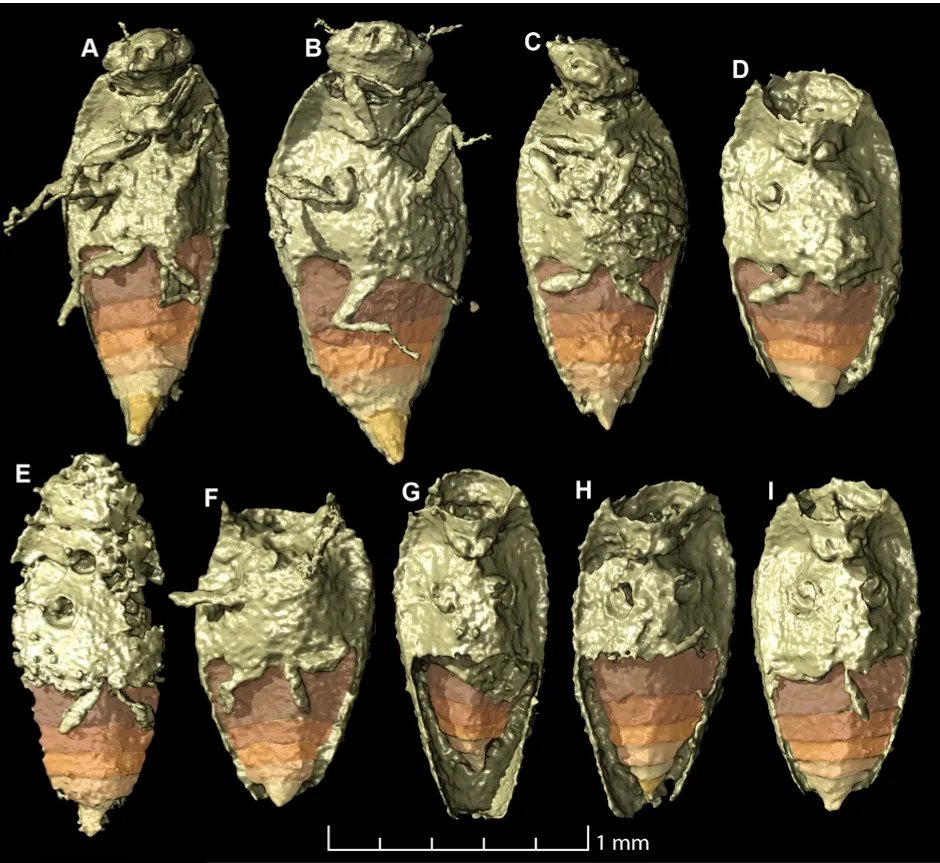A tiny beetle has the dubious honour of being the first-ever insect to be described from fossilised faeces.
A team of vertebrate palaeontologists and entomologists used a technique called ‘synchrotron microtomography’ to create 3D reconstructions of beetle remnants while they were still trapped inside a fossilised poo from the Triassic Period. The poo was found in the Krasiejów region in Poland.
The fossilised poo, called ‘coprolite’, contained a number of near-complete beetles, with some of the antennae and legs still intact. The majority of the specimens belonged to the same species of beetle, which the scientists have now described as Triamyxa coprolithica.
As the beetles were so well preserved, the researchers were able to establish that T. coprolithica represents a previously unknown extinct lineage of the suborder Myxophaga, whose modern representatives are small and chow down on algae in aquatic environments.

The producer of the poo was an ancestor of the dinosaurs called Silesaurus opolensis that lived in Poland around 230 million years ago.
"We were absolutely amazed by the abundance and fantastic preservation of the beetles in the coprolite fragment,” said Martin Qvarnström, researcher at Uppsala University, Sweden, and one of the co-authors of the paper. “In a way, we must really thankSilesaurus, which likely was the animal that helped us accumulate them.”
Silesaurus was small, measuring about 2.3 metres in length and weighing approximately 15kg. Fossilised remains suggest that the animal had small, conical teeth and may have had a beak at the tip of its jaws, which it could have used to root around for insects in leaf litter.
Read more about fossils:
- Could there be fossils on Mars?
- How to hunt for fossils in the UK
- How do dinosaur footprints get fossilised?
The researchers think T. coprolithica was too tiny to be the main source of food for Silesaurus. Instead, these insects probably shared a habitat with other prey and larger beetles, none of which were possible to identify in the coprolite.
"I never thought that we would be able to find out what the Triassic precursor of the dinosaurs ate for dinner," said Grzegorz Niedzwiedzki, palaeontologist at Uppsala University and one of the co-authors of the paper.
Specimens of insect fossils tend to come from amber, which beautifully preserves the tiny invertebrate bodies. But amber generally comes from more modern periods of geological time, from the Cretaceous onwards.
The Triassic was an important period of early evolution and diversification of insects, including beetles. The majority of our understanding of Triassic beetles comes from poorly preserved fossils. This study has shown that coprolite may offer an alternative route for researchers to study ancient insects, and also the diets of extinct vertebrates.
Reader Q&A: Why do some insects look metallic?
Asked by: Rebecca Walker
Many insects, particularly scarab and jewel beetles, have vivid, metallic green, blue or gold colouration. This effect doesn’t come from pigments, but is an example of ‘structural colouration’.
Microscopic ridges and transparent layers on the surface of a beetle’s carapace act as an array of lenses that direct different wavelengths of light in such a way that some colours cancel out and others are amplified – the rainbow effect on a DVD is similarly caused by the microscopic pits on its surface.
This metallic sheen may have evolved because it offers bright colours that can serve as a mating signal over long distances. Alternatively, some researchers have suggested that it might mimic the appearance of raindrops on leaves, helping to camouflage the beetles.
The ridges and layers may also take less energy to grow than metabolically expensive pigment molecules – particularly important for insects because they regularly shed and regrow their outer skin.
Read more:
